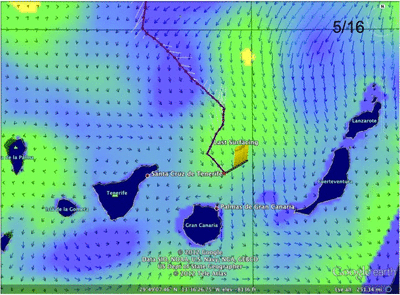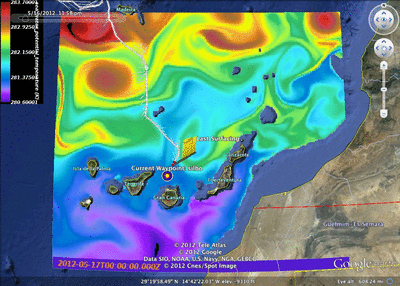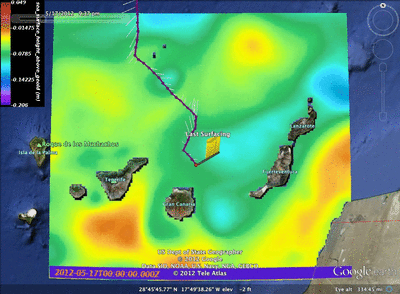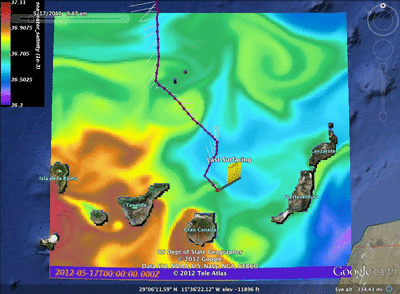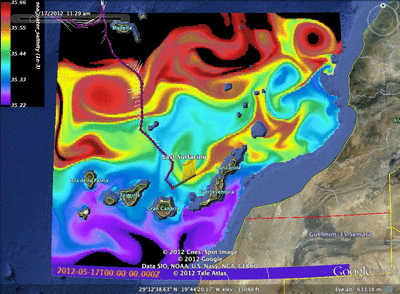Hey all,
Yesterday was quite an amazing day. First off, I would just like to acknowledge that yesterday, May 22, was National Maritime Day where in the US we honor those who are dedicated to promoting commerce and protecting our freedom.
Secondly, the company SpaceX launched its first commercial space craft, carrying cargo to the international space station, taking a huge step towards regular space travel post NASA’s Shuttle Program.
In other news, THE BEAR IS IN THE IGLOO!!!! Yesterday morning at about 11am Canary time, Silbo was picked out of the water thus completing the mission he set forth on nearly 11 months ago. Although there were some complications near the Azores which led to a hiatus as we waited upon new batteries, Silbo spent 238 days at sea covering 5555km as he bravely made the journey from the arctic waters of Iceland to the subtropical waters of the Canaries.

Some small fish swimming around Silbo in celebration
The morning started when we all (Antonio (ULPGC), Lauren(TWR), Alvaro(PLOCAN, and myself (Rutgers) ) met at the marina at 7:30.

We then met with the crew, Jose Blanco and Juan Carlos Gacia, and talked with the captain, Patricio Morenes and he described the strategy of how they wanted to pull Silbo on board when we got on site. After we went and grabbed some coffee, we left port aboard the “patrullera SALVAMAR -NUNKI” by a little past 9am.

On our way out the seas were a little rough, with waves of 2.5 m (~8.5 feet) but with little wind. The boat we were on was very fast, capable of traveling over 35 knots, however we stayed around that speed except when the Captain would cut the engine when we hit waves that were too big.
After a little over an hour of sailing out, it was time to set up the recovery station.


After the freewave and computer were set up, the waiting commenced as Silbo was set to surface somewhere near 11am. So we waited…

Until finally, the computer chirped indicating Silbo was finally calling in! We got an updated gps point from Chris back on shore in the US (thanks again for being up with us so early!) and we adjusted our position a little until Juan made the first sighting!


After sighting, the captain slowly approached the little droid, bringing it to the starboard side. The strategy: lasso Silbo to drag him to the stern where there was a platform where we could easily pull him aboard. On the first attempt, we didn’t even have a chance to throw the rope as Silbo zipped by the ship just narrowly missing the hull.

On the second try however, we roped him!

Juan and Jose moved Silbo around back making sure he kept a safe distance from the ship as they prepared to pull him on board.



And then, shortly after 11am on May 22, 2012, THE BEAR was officially IN THE IGLOO!!!

El oso está en el iglú!
So finally, after crossing through subarctic waters, the Gulf Stream, Azores Front, Mediterranean subsurface eddies, investigated the effects of two powerfull storms (Irene and Katia) over the North Atlantic, and finally touched the Antarctic Intermediate Waters, Silbo is safe on shore. Truly Silbo has shown the capabilities of the glider for future ocean exploration.

Lastly, today Silbo received a warm welcoming as a press conference was held at the University of Las Palmas, Gran Canaria.

http://eldia.es
The Next: We had a small amount of biofouling, the dreaded Gooseneck Barnacles again! What I plan to do is to measure the length of the barnacles and Antonio will use his algorithm to predict when and where they latched on.

This will give us valuable information of what conditions we will need to keep an eye on for future missions as we then cross track the estimated date with the data collected from the CTD and any archived ocean model data we have. However, Silbo’s siesta will not last very long.

Next on our agenda, is to take Silbo from Gran Canaria, and pass by Cape Verde on our way to Brazil and beyond! The new battery packs will arrive in Gran Canaria shortly, so once they are through customs, Chris DeCollibus from TWR will make his way out to re-battery and redeploy!
But as for now,
Force Wind Sea and Honor
Nilsen, Antonio & Lauren
P.S.
Articles Celebrating Silbo’s Success (en Espanol):

































































